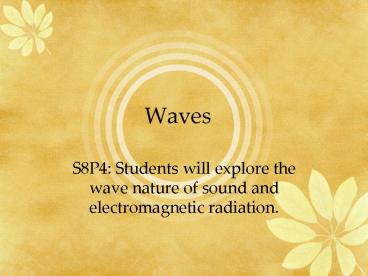Waves - PowerPoint PPT Presentation
1 / 13
Title: Waves
1
Waves
- S8P4 Students will explore the wave nature of
sound and electromagnetic radiation.
2
ENDURING UNDERSTANDINGSStudents will understand
that
- Energy is neither created nor destroyed it can
be transformed from one form to another. - Waves carry energy.
- Mechanical waves are created when a source of
energy causes a medium to vibrate. - Waves can change direction (refract, diffract,
and/or reflect) when they encounter matter.
3
- The energy of the wave changes as it travels from
one medium to another. - The wavelength and amplitude determines the
characteristics of waves. - The pitch of a sound wave is related to its
frequency and its intensity is related to its
amplitude. - The characteristics of waves are affected by the
type of medium. - The colors observed by the eye are the result of
the multiple wavelengths reflected by the object.
4
Identify the characteristics of electromagnetic
and mechanical waves.
- Electromagnetic waves
- Can travel through a vacuum
- Radiation is the transfer of energy in the form
of EM waves - EM waves can interact with mediums (absorption,
reflection, diffraction, refraction)
5
- Electromagnetic Spectrum
- An EM waves frequency determines the waves
characteristics. - The higher the frequency, the more energy the
wave carries. - Radio waves are long, low-energy EM waves
- Infrared, visible, and ultraviolet light have
mid-range wavelengths and frequencies - X-rays and gamma rays have short wavelengths and
high frequencies. High-energy waves.
6
- Mechanical Waves
- Travel through a material, called a medium,
transferring energy - The medium moves as the wave passes through it,
but returns to its former position after the wave
passes - Transverse wave- travels in the direction
perpendicular to the disturbance that caused it - Ocean wave, seismic wave, rope wave
- Longitudinal wave- travels in the same direction
as the disturbance that caused it - Sound wave, slinky wave when laying flat
7
Describe how the behavior of light waves is
manipulated causing reflection, refraction,
diffraction, and absorption.
- EM waves can interact with material mediums in
the same way as mechanical waves do. - reflection, refraction, and diffraction.
- Objects that transmit most of the light that
strikes them appear transparent. - Objects that transmit some of the light that
strikes them but cause it to scatter appear
translucent. - Opaque objects do not transmit light.
8
(No Transcript)
9
Explain how the human eye sees objects and colors
in terms of wavelengths.
- Visible light reflected from an object gives it
color - a green leaf reflects green wavelengths and
absorbs all other visible wavelengths.
10
Describe how the behavior of waves is affected by
medium (such as air, water, solids).
- Since waves move through matter (a medium) the
arrangement of the particles affects the speed at
which it travels - Waves move faster through solids
- Waves move slower through gases such as air
11
Relate the properties of sound to everyday
experiences.
- High frequency sound waves create a higher pitch
sound - Lower frequency sound waves create a low pitch
sound
12
Diagram the parts of the wave and explain how the
parts are affected by changes in amplitude and
pitch.
13
- Pitch is associated with the frequency of a sound
wave- the higher the frequency, the higher the
pitch. - Loudness and Energy level is associated with
amplitude- the higher the amplitude the more
energy or louder the sound































